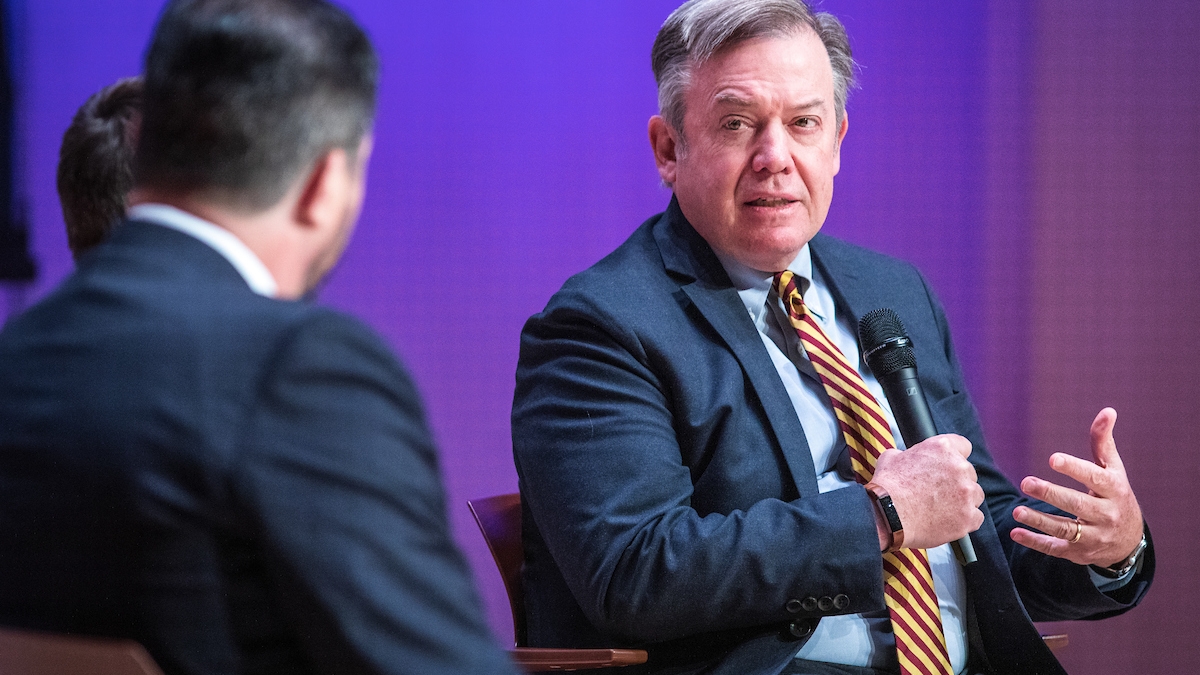Arizona's 3 university presidents promote research as economic driver

Arizona’s economy is strong, but it will require investment in research at the state’s three public universities to grow enough for the future, according to the colleges’ presidents.
“Arizona’s economy turns out to be successful but not resilient,” said Michael Crow, president of Arizona State University, who spoke at the "Valley Voices" talk sponsored by the Greater Phoenix Chamber at the Musical Instrument Museum in Phoenix on Thursday.
“It’s successful but not capable of generating the kind of economic growth, beyond population growth, that we’d like to see. To do that, one needs to lay the foundation in a significant way for the new economy," he said.
Crow said that rapid technological changes will make the current ways of doing things obsolete. So ASU is asking the state to invest in expanding the Ira A. Fulton Schools of Engineering.
“We will build inside ASU, as part of the new economy for the future of Arizona, an engineering school that is larger than the entire entity of Georgia Tech,” he said, adding that the return on that investment will grow the state’s economy by $50 billion over 20 years.
Rita Cheng, president of Northern Arizona University, said that research prepares students for the workforce.
“We’re 10% of the research strength of our sister institutions, at about $58 million, but we have become world class in a few key areas — ecology and forestry, astronomy and health, as it relates to underrepresented communities in Arizona,” she said.
“The power of the research at NAU is the impact it has on students, and why Arizona should care is that our undergraduate students, and our graduate students, whether they aspire to be the next generation of faculty, or they go into industry, which your companies want, they’re not coming from institutions that are hearing about research or reading about somebody else’s discoveries. They’re there. They’re having this deep, experiential learning that’s so important to Arizona.”
The "Valley Voices" event at the Musical Instrument Museum on Thursday, sponsored by the Greater Phoenix Chamber, included (from left) Jaime Molera, public affairs chairman for the chamber, who moderated the talk, NAU President Rita Cheng, ASU President Michael Crow and UArizona President Robert Robbins. Photo by Charlie Leight/ASU Now
Robert Robbins, president of the University of Arizona, said that competing for big federal research grants requires universities to attract high-level people, citing the Osiris-Rex asteroid mission.
“That’s a billion dollar project and others are coming,” he said.
“Oftentimes you have to invest money just to get money. For those $100 million-plus grants, you almost have to invest in a million-dollar planning grant to get it together. So we have to have philanthropy and contracts with companies.”
Robbins said that the three Arizona universities are a powerful force in research.
“I think we’re not competing against each other, we’re competing with the (University of California) system, the (University of Texas) system, the Harvards and Princetons and Stanfords of the world,” he said.
Research that starts with professors in university labs are spinning off into successful businesses, Crow said.
“Universities are powerful transformative forces if you can build a critical mass of discovery and problem solving,” he said, citing Klaus Lackner’s carbon-capture technology and Cody Friesen’s hydropanels that generate clean water from air.
“We have 30,000 people involved in research enterprise at ASU and 11,000 separate projects. We went from not being in the top 200 of patenting universities to the top 10.”
The presidents also talked about how they have increased access to higher education.
“The barriers that some families perceive in college attainment is a difficult conversation across the country. Finances and pathways to college or to technical school or to community college should be clear and they’re often not, particularly to first-generation students, which Arizona has a lot of,” Cheng said.
She said that her university is nearly at 25% Hispanic students, and that many of its Native Americans are third-generation NAU students.
“But it’s still a question of how we work with communities who may be concerned that, 'If my child is educated, they won’t come home,'” she said.
Robbins cited the University of Arizona Medical School’s recent initiative to provide free tuition to graduates who agree to stay in Arizona and work in underserved communities. But there are difficult challenges getting through college.
“Many of our students work not one but two jobs, and housing insecurity and food insecurity are major problems that every university in this country is facing,” he said.
Crow said that ASU went from an overwhelmingly white university with a four-year graduation rate of 12% in the 1980s to having a student body that represents the socioeconomic spectrum.
“I’m not saying the university was bad back then but it wasn’t set up to serve the people. Now, 42% of the kids from Arizona are eligible for Pell grants and almost half the freshmen class is not white,” he said.
“That’s a designed outcome. The way we became more diverse was, one, we wanted to do it, and two, we had to have the means to do it and both of those things have been solved.”
Top image: ASU President Michael Crow speaks at the "Valley Voices" panel discussion held by the Greater Phoenix Chamber at the Musical Instrument Museum in Phoenix on Thursday. Photo by Charlie Leight/ASU Now
